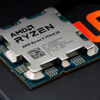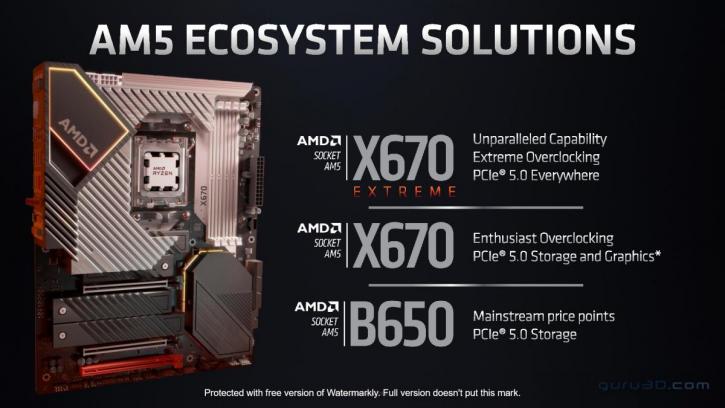PCI-Express 5.0 and the 600 Series Chipset
X670E/X670, and B650E/B650 Motherboards
Chipsets will be formed of the X670E, X670, B650E and B650. AMD AM5 infrastructure is paired with that LGA 1718 socket and requires new chipsets. The 600-series platform comes equipped with DDR5 memory and PCI Express Generation 5 for storage and graphics. The platform supports 24 PCIe 5.0 lanes, 16 for the video card, four for an M.2 slot, and four more for connecting to the chipset.
The most opulent X670E chipset, where the E stands for 'Extreme,' can support two video card ports and an M.2 slot for an SSD with PCIe 5.0 bandwidth. Only the SSD on the B650 operates at PCIe 5.0 speeds. AMD has stated that the X670E chipset is designed for "unrivaled capability and extreme overclocking." It is designed to be able to supply PCI Express Gen 5 "everywhere." An X670 is designed for Enthusiast Overclocking and features support for Gen5 storage and optional graphics. Only the PCIe Gen5 storage standard will be supported by the mainstream platform based on the B650 chipset. The motherboard part of the 600 series will also include up to 14 SuperSpeed USB 20 Gbps (TypeC), and WiFI-E6 with DBS/Bluetooth Low Energy 5.2. Interestingly. Additionally, AMD has announced that the motherboards in the 600-series will come equipped with up to four HDMI 2.1 and DisplayPort 2 outputs. Mainboards with the chipsets B650 and B650E are expected to push the new socket AM5 platform for Ryzen 7000 CPUs into the lower-priced territory. The X670 and X670E variants are projected to be quite pricey.
The distinctions between the B650(E) and the X670 (E)
The differences between the chipsets are illustrated in this AMD picture. The B650(E) only has half as many USB and SATA ports as the X670 versions. PCIe 5.0 is optional on the B650 and is exclusively meant for an M.2 SSD port. The B650E, on the other hand, has PCIe 5.0 for both the graphics card and an SSD, for a total of up to 20 PCIe 5.0 lanes.
Socket AM5
AM4 has been serving since 2016; AMD's Ryzen 7000 series has announced its retirement of the socket AM4 platform. This marks AMD's transition to PCI Express 5.0 and DDR5 memory. The AM5 LGA socket contains 1718 pins, which significantly increased over the AM4 socket, which had 1331. That increase is partly needed for DDR5, and 24 PCIe 5.0 lanes. Four lanes presumably just link to the chipset. After allocating 16 lanes to the graphics card, there will be 8 lanes left, four for direct-CPU-attached M.2 SSDs, and four lanes are used as interconnect. Remember, though, PCIe 5.0 video cards are not yet available. BTW your CPU cooler you can carry over towards the new platform as they will be compatible between AM4 and AM5 with the same mounting system
DDR5
The new platform will officially support DDR5. The controller is officially compatible with speeds up to DDR5-5200 (JEDEC default). However, AMD's Ryzen 7000 Zen 4 CPUs appear to have a sweet spot of DDR5-6000, allowing for a 1:1 IFC ratio (Infinity fabric Interconnect). A 1:1 ratio means that the memory runs at the same frequency as the memory controller on the CPU, which is the best-case scenario. With Alder, Intel has separated the memory ranks into two categories: a 2:1 mode known as Gear 2 which is the DDR5 default, and a 4:1 version known as Gear 4. A 1:1 ratio offers the advantage of allowing for lower latencies and faster speeds. A higher ratio, on the other hand, allows for better overclocking and faster data transfer rates but also results in higher latencies. DDR5-6000 for AMD Ryzen 7000 "Zen 4" CPUs already sounds amazing for AM5, with a default to DDR5-5600. Higher frequency DIMMs are supported; however, if you exceed the DDR5-6000 limit, you will be forced to use a 1:2 IFC. DDR5-6400 operating at 1:2 is said to offer poor results and is not advised if you want better gaming performance. AMD has been working on a new overclocking standard for DDR5 memory called EXPO, which the company intends to use as a competitor to Intel's XMP 3.0 protocol. AMD revealed earlier this year that it is working on Ryzen Accelerated Memory Profiles. EXPO will be the memory module equivalent to Intel XMP 3.0, storing compatible ddr5 overclocking profiles with faster speeds and tighter frequencies. It is also advertised as a one-click memory overclocking solution.



